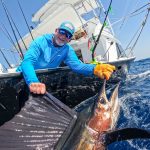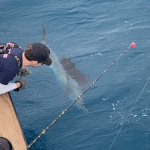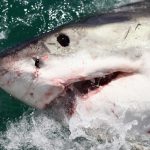Updated Videos on ROFFS™.com – Be Sure to Check Out the “Hot News” Button on the ROFFS™ Homepage
Marlin!

Slick video by Mate Steven Cambronero Fallas – Mate Jose Francisco Brenes Zuñiga on the wire. Capt Carlos Pollo Espinoza Jimenez and the #seaflynation team getting the marlin! Video Courtesy: Sea Fly Sportfishing | Facebook
Please click HERE to watch the video on our website now!
455 Pound Swordfish!

Since it’s been blowing 30+ in Islamorada I figured I’d share part two of the 455 lb swordfish we caught back in September 2011. After 5 hours we finally got the harpoon and gaffs into the big Broadbill Swordfish, but she didn’t give up easy! It’s the second biggest one we’ve caught hand cranking here in Islamorada, Florida Keys. Video Courtesy: Capt. Nick Stanczyk | Facebook
Please click HERE to watch the video on our website now!
Slam!

Just a little reminder of how close it really is!! Video Courtesy: Tightline Tours | Facebook
Please click HERE to watch the video on our website now!
Fun Ride!

This looks like so much fun! Video Courtesy: Distractify | Facebook
Please click HERE to watch the video on our website now!

Above: ROFFS™ Clients Toby Lamm and Captain Dave Morby (Sea-Mor) had a great day on the water fishing Walker’s Cay area fishing the eastern side of the Gulf Stream. Thank you ROFFS™ – Fridays report guided us on Sunday to 12 Yellowfin Tuna (32″ up to 57″) & some small dolphin. Lots of life in the areas we fished.
Please click here to view our updated online photo gallery!
ROFFS™ Gulf of Mexico Early Season Preview 2017 – GULF OF MEXICO CONDITIONS LOOKING GOOD
We are providing an early spring analysis of the oceanographic conditions for the Gulf of Mexico region using a combination of satellite data including sea surface temperature (SST) and ocean color/chlorophyll images from late March 2017. We will discuss the overall ocean conditions for the current spring fishing season and how they may transition into the summer conditions.
Roffer’s Ocean Fishing Forecasting Service, Inc. – ROFFS™ (roffs.com) has a 30+ year history of monitoring the ocean conditions throughout the Gulf of Mexico for research and fishing applications. Infrared (IR) satellite data is used to observe the SST and ocean color data is used to derive indices of phytoplankton (chlorophyll), water clarity, and colorized dissolved organic material (CDOM). Combined with other oceanographic data and in sequence, these data allows one to visualize the dynamic ocean currents. The satellite data is derived from a variety of sources including NASA, NOAA, Suomi National Polar-orbiting Partnership (SNPP), and the European Space Agency (ESA). ROFFS™ also uses a plethora of different data derived from drifting buoys, gliders, aircraft, fishing vessels, and satellite altimeters. The altimeter data provides a relatively coarse spatial (~15 mile) and temporal resolution (5-10 days) that limits the data’s usage for studying large-scale circulation. It is not useful for evaluating smaller scale and short-term (daily and sub-daily) changes in the ocean currents or their water mass boundaries that control the location of forage fish and the larger, more valuable predator fish.
Background and Some Observations for 2017
It is important to look at the year-to-year trends and anomalies to get a better understanding of how the ocean conditions compare regarding the conditions and location of the fishes preferred habitat and the likelihood of a productive fishing year. Comparing the similar locations and features to last year, the SST of the core of the Loop Current for late-March 2016 was 79.5°F – 80.0°F and for this year over the same time period, it was 81.0°F, which is 1.0°F – 1.5°F higher. This warmer-than-last year trend continues throughout the Gulf of Mexico region. It is important to note that the SST in the offshore northwestern Gulf of Mexico is 73.5°F – 74.5°F, which is 3.0°F – 4.0°F higher than last year at this time. Similarly, the SST in the offshore southwestern Gulf of Mexico area was observed to be in the 76.0°F – 77.0°F range this year, which is 2.0°F – 3.0°F higher than last year. Also, in the mid-Gulf area the SST was observed in the 74.0°F – 75.0°F range and approximately 3.0°F – 4.0°F higher what we observed in 2016.
Also of note is that the coastal SST’s along the west coast of Florida to the western Gulf of Mexico range 4.0°F – 5.0°F higher than they were during the same time period (late-March) last year. These substantially warmer SST’s suggest a much earlier arrival time of the species that you usually target in May (e.g. yellowfin tuna, wahoo, dolphin, kingfish, sailfish, marlin, swordfish, cobia, etc.). Recent reports indicate that the cobia have already arrived just offshore of the Florida panhandle and kingfish fishing action started in the middle of March off of Tampa. In addition, there have already been some reports of marlin, wahoo and good yellowfin tuna action south of Louisiana and in the northeastern Gulf of Mexico. When the satellite tag data are reviewed for the winter of 2016-2017, it will be of particular interest to see if the yellowfin tuna moved to their usual overwintering area in the southwest Gulf of Mexico, or remained in the central Gulf.

Please click HERE to read the full forecast on our website now!
River of Mud!

River of mud destroying this town. Horrible!
Please click HERE to watch the video on our website now!
Doing Work!

Captain Tyler Macallister of @fvcynthiac doing work for an upcoming episode of @onthewatermagazine. Video Courtesy: Skillie Fishing Apparel | Facebook
Please click HERE to watch the video on our website now!
Fish Artistry!

A MASTERPIECE in the SEA! Video Courtesy: Bettie Kinuthia | Facebook
Please click HERE to watch the video on our website now!
Backlash? Feedback?

As always, please send comments & feedback on Fishy Times newsletter content directly to us at feedback@roffs.com.
If you do not want to wait for our next Fishy Times newsletter, please visit us in the meantime to get all your fishing news on Facebook, Instagram, Twitter, YouTube and on the web. Safe and successful fishing until next time!






